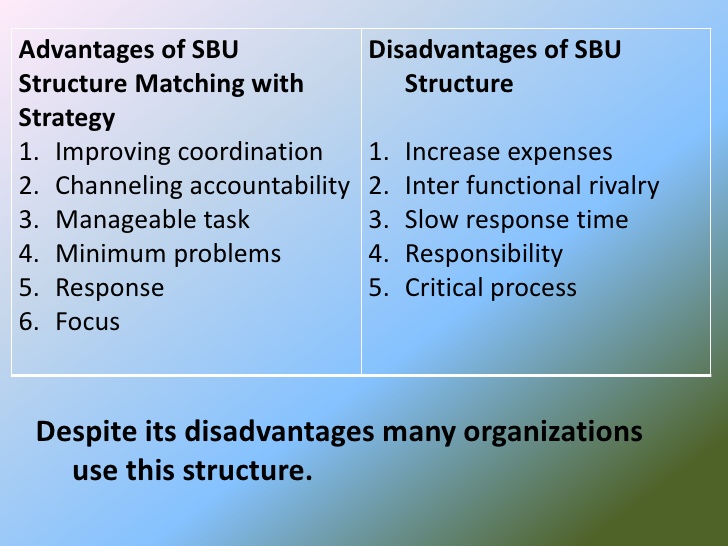What is the Strategic Business Unit (SBU)? The complete guide
SBU seems to be a strange term, but if you are about to grow your business in terms of size and product categories, it is necessary to understand the basics of a strategic business unit.
Knowing its importance to any business owner, we would like to introduce this post, which will cover the definition and the complete guide to set up a strategic business unit.
Let’s dive in!
What is a strategic business unit (SBU)?
A strategic business unit (also known as SBU) is a business term used to present an independently managed entity or unit of a large company. Those strategic business units often have their own visions, missions, objectives, and course. Moreover, their planning is done separately from other businesses, and their goals are different from the parent enterprise and elemental to the long-term performance of the business.
In other words, a strategic business unit is an array of a huge corporation that is responsible for its shared planning treatment. They can be business divisions, product lines of the division, or a particular product/service. No matter what SBUs are, they all target a specific group of customers or a geographical area.
Despite working independently, the strategic business unit still has to report directly to the parent organization’s head office when it comes to the status of their working process and performance. Normally, the strategic business unit looks at a specific market or industry.

Being an array of the main company doesn’t mean SBUs are at the small business size. On the other hand, they are large and have their own support functions. They can obviously control Human Resource Management (HRM), training & development, and marketing works. Having strategic business units is extremely important because they provide many benefits to businesses. Especially when the main companies have multiple product structures, they should know and set up SBUs structure. Having one or many SBUs, a business can have them respond quickly to shifts in product markets.
One typical example of SBU structure is famous brands like LG. They provide a long list of consumer products such as fridges, televisions, air conditions, and more. Each of them is made by different strategic business divisions. They are responsible for manufacturing and delivering products but have to take into account making decisions, investments, and budgets. In this way, LG’s main business can spend more time and attention on tracking costs, income, and profits.
Read more:
Examples of a strategic business unit
Being responsible for its own strategy and bottom line, a strategic business unit can be a division, a team, or a completely separate business. Also, they can be a marketing team that helps the whole company in operational functions. Now, we will show you some simple examples and different types of strategic business units.
Products
A large company can split up into small ones based on the product categories it provides. This type is the most common one when it comes to SBU. For example, a snowboard manufacturer decides to set up two strategic business units because it owns two product divisions, which are fashion and equipment.
The fashion division and the equipment division have the same brand name and administrative functions, such as best HR software and information systems.
Services
Similar to products, companies also build up the strategic business unit according to their services. For instance, a telecom company can set up a data center division. This division will help the parent company in providing different services like a colocation data center.
Locations
The location category or Region category is when a business targets customers from different nations or areas. A European fashion brand launches a Japanese distribution and promotion capabilities and takes it as a strategic business unit to help the company sell more products to Japanese consumers.
Customer Segment
When it comes to the customer segment, a business can have a separate division to service high net world individuals. One industry that is familiar with setting up SBUs based on the customer segment is Banking.
Innovation
The innovation category is used, especially when it comes to innovative products or devices. For example, a huge information technology business can be split up into strategic business units to launch its new innovative products. The unit is applied as a growth investment and avoids spending too much after launch.
The structure of a strategic business unit
The structure of a company setting up SBUs consist of Operational units. Those units work as autonomous businesses. Within the SBUs structure, the highest corporate officials tend to assign the responsibilities of the company to the division owners in terms of regular operations and business unit strategy. Easily put, the parent officer has the responsibility of developing and executing the comprehensive strategy and managing the SBU via strategic and financial controls (also known as financial checks).

That means the senior executive has the right to make decisions for each unit since the SBU structure connects related divisions of business and the strategic business unit. What’s more, those senior executives have to follow the rules and are supervised by the head executive officer.
When it comes to levels of a strategic business unit, there are three which includes:
- The corporate headquarters stay at the top.
- Strategic business units’ are in the middle.
- Divisions that are assembled based on the similarity within each strategic business unit remain at the bottom.
You should keep in mind that each SBU will be considered an independent business when it comes to the strategic viewpoint. That means the SBU groups are independent of each other, and the SBU divisions are connected.
In the SBU system, a single strategic business unit is regarded as a profit center and is led by corporate officers. The parent supervisors focus on strategic planning instead of checks or operational control. If there are little or no checking and interactions between the strategic business units and the head company, the SBU’s separate divisions can respond extremely quickly to changing business environments.
Characteristics of a strategic business unit
In general, a strategic business unit has the following characteristics:
- SBU is a separate business or a group of similar businesses that are in charge of scope for autonomous planning.
- Strategic business units do not have the same set of rival companies as the others
- The head of a strategic business unit will be responsible for the profitability, performance, and strategic planning of the specific unit.
- SBUs work in different markets and target different groups of customers.
- SUBs have different expertise in production or management that do not exist in the parent business.
The advantages and disadvantages of strategic business units
Although strategic business units are important to any business, it still holds some drawbacks. Before deciding whether to set up a strategic business unit or not, let’s review its pros and cons:
The advantages of strategic business units
- Strategic business units simplify the Strategic Management process.
- Strategic business units help the association between different company departments.
- Strategic business units make it easier for the bookkeeping process of high-volume organizations.
- Setting up strategic business units is simple and easy when it comes to monitoring and checking.
The disadvantages of strategic business units
- It is hard to communicate with upper management.
- Strategic business units can result in internal tension, which is directly made by access to sources of funding.

How to set up a strategic business unit
Setting up a strategic business unit (SBU) is beneficial because organizations creating SBUs can develop and gain success to new products, markets, or technologies, whereas they can avoid the drawbacks of working in huge businesses. The strategic business units will have their own managing team, brand name, reputation, objectives, and physical locations. In this way, those companies can work more effectively in a smaller organization and are not bound by the limited availability of resources. Also, they can grow and gain more sales thanks to the advantages of a larger company.
For example, strategic business units can save time and effort spent on building an established brand and broad base of customers that already exist in the parent organization of the SBUs. At the same time, they can prevent themselves from common challenges of the larger company such as excessive bureaucracy.
After knowing the importance of setting up an SBU, you should consider some requirements below. They look at organizational structure, recruitment & selection, corporate culture, and the remuneration system, which you should concern about before building a strategic business unit for your company.
Organizational structure
The first requirement is adapting the organizational structure. That means the organizational structure will be soon changed when you decide to switch to a different strategic business structure. If your company adapt the organizational structure, you are free and independent in experiencing, making the experiment, and significant changes. Separating business units from each other allows you to prevent creativity that is suppressed by process and branding problems. However, large bureaucratic companies are often not flexible and agile.
Recruitment and selection process
The managing team working in the strategic business unit is not those working in the parent company. Therefore, when setting up an SBU, you should change the recruitment and selection process. It is about building up a new company within a different market rather than leading a developed one. The staff that excel in the head company will have many challenges if they have to apply what they know into running a new unit. Similarly, a strategic business unit can’t develop well if its managing team knows little or nothing about the SBUs.

So, if you are about to open an interview to recruit people working for your SBU, focus on asking about the organizational objectives instead of the general knowledge about the parent brand. This recruitment process can help build an internal relationship and keep the team motivated. Remember to hire people who want to build a new business from the ground up as well as learning experiences from an uncertain but experimental environment like SBUs.
The remuneration system
When a business grows up and the company gains more and more in reputation and fortune, business owners tend to provide shares, money, gifts, or other important financial incentives to encourage and motivate their employees. However, it does not mean those high-volume companies always have to offer incentives for them.
On the other hand, according to Frederick Herzberg’s two-factor theory, “financial incentives only partially influence employee motivation”. In fact, they are more motivated by their own careers, which means recognizing them for their hard-working within the business and letting them grow along with it.
The corporate culture
The last requirement when it comes to setting up a strategic business unit is adjusting the corporate culture. Besides financial incentives, business owners need to concern about giving them other benefits to keep them motivated. What you need to do is make your employees feel like they are listened to and appreciated for their contributions to the success of the company. Or else, they will easily get fed up with and unsatisfied about the toxic working environment and working conditions.

Listen to them, ask them about their wishes and demands, and try to fulfill them as much as possible. For example, an employee wants to work at night because he finds he works better at night, change the corporate culture, and allow him this night-shift option.
Related posts:
- What is Personal Branding?
- What is Co-Branding?
- 15 Key SaaS Metrics that every Business should care about
- How to conduct a Brand Audit ?
Summary
A strategic business unit (SBU) is an ideal tool to help a business target its group of customers more effectively. Some expertise said that larger organizations should not split up into strategic business units since it holds some existing disadvantages. Nonetheless, setting up a strategic business division is challenging but rewarding as long as you make it correctly.
Hopefully, this post can give you something essential for your success in eCommerce business work. Give the strategic business unit a try if you haven’t applied for it before or you want to grow your business to a higher level. If you find this post interesting, remember to share it with your friends.
Do we miss anything? Do you want to add any tips or knowledge? Please be free to leave a comment in the section below and we will reply to you soon.
New Posts






